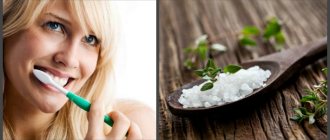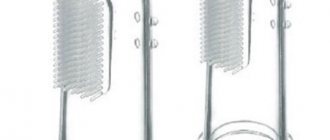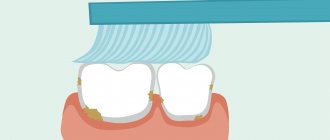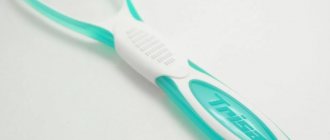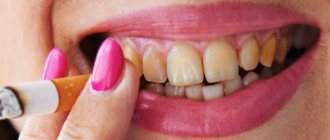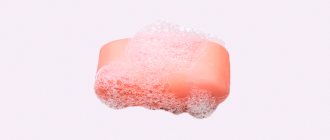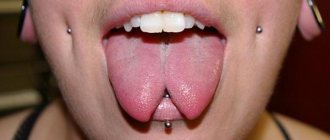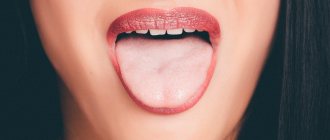- Why do you need to clean your tongue?
- How to clean your tongue
- How to clean your tongue
For many people, oral hygiene ends with brushing their teeth. However, cleaning your tongue is also necessary and important. Plaque and bacteria accumulate on it, from which caries develops and an unpleasant odor appears.
Regular tongue cleaning helps to avoid diseases such as stomatitis, gingivitis, caries and even periodontitis. Now we will look in detail at why you should clean your tongue and how to do it correctly and effectively.
Did our ancestors clean their tongues?
People began using tongue cleaning devices at least five centuries ago. An example of this is the mention of the need to cleanse this organ of our body in the treatises of the 10th century AD. Uzbek doctor Avicenna. For the most effective procedure, he recommended using cypress cones and tree slivers, which are rich in essential oils. In ancient China, members of the nobility used a tongue scraper to clean their tongues before each meal, as it was believed that thanks to this procedure they could fully appreciate the taste of the dishes. Residents of our country made special scrapers from silver, which disinfected the oral cavity and prevented various inflammations such as mouth ulcers, candidal stomatitis, various types of glossitis, etc.
Rules for using a scraper
Regarding “don’t overdo it” – what does that mean? Since the tongue has a villous surface, you should not press hard on the scraper and try to remove the plaque along with the layer of papillae. Under no circumstances should there be injury . The movements are smooth, without excessive pressure from the root of the tongue to the tip over the entire surface.
As for the gag reflex - yes, of course, the sensation is not pleasant and, most importantly, uncontrollable, but despite this, you can fight it. As they say, a person gets used to everything and human language is no exception to this. The tongue can be trained to scrape, in the truest sense of the word. To start, use the scraper only on the tip of your tongue. Every day, every day, increase the area being treated until you cover the entire tongue. This adaptation may take from one week to a month.
Smokers should pay special attention to the condition of the tongue, since the formation of plaque, sedimentation of resins and temperature irritants can provoke the occurrence of unpleasant diseases, such as “black hairy tongue” and even cancerous tumors!
Take good care of yourself: wash your hands before eating, brush your teeth twice a day, and don't forget about your tongue. And remember that the mouth is the entry point for infection into the body and must be kept clean!
Cleaning your tongue with a tongue scraper
Nowadays, tongue scrapers take pride of place in the list of oral hygiene devices. Almost all of them are made of plastic and are a nozzle with a spoon-shaped tip. This excellent tongue and cheek remover needs to be replaced as often as toothbrushes. If you use it together with a rinse aid, the quality of the procedure will be one level higher. You can buy a tongue scraper at a pharmacy or order it from an online store.
Equipment and hygiene products
When choosing hygiene accessories and compositions, you must be guided by personal preferences. In this case, it is still better to consult a doctor to prevent the negative consequences of seemingly safe care.
Scrapers for cleaning
A flat oval or triangular device looks like a spatula. It is made of silicone, plastic, wood, metal and other materials (the latter are less common). The user delicately cleanses the mucous membranes, preventing tissue injury.
The item does not cause a gag reflex due to its design. Small plastic or silicone bristles gently remove the bacterial layer. The device is quickly and easily washed under the tap.
Spoons
These are elastic nozzles with a tip in the shape of a small spoon. It is enough to run the accessory over the surface several times. Water is supplied through the hole, which makes the procedure more effective and soft.
Irrigator attachments
They come complete with the device and are spade-shaped. When the device is operating, a solution is supplied from the reservoir under high pressure. The liquid reaches hard-to-reach areas that cannot be reached in any other way. Thanks to this, the interdental spaces and gums are cleaned. The pressure mode can be set manually by the user.
This method of cleansing at home is the most effective. As a result, not only accumulated plaque is removed along with pathogenic microorganisms, but also unpleasant breath disappears, the risk of developing dental diseases is reduced, and the enamel brightens.
Brush attachments
In pharmacies and specialty stores you can purchase replacement tips for delicate but effective oral hygiene. As a rule, they combine soft or medium-hard bristles, as well as rubberized elements, which allow you to remove the bacterial layer.
The only inconvenience is the need to change various devices during daily care, since due to the insufficiently rigid structure, the dental units will not be completely cleared of food debris. For convenience, an irrigator is preferable.
What does cleaning the tongue with special brushes give us?
There are multifunctional devices that can be used to reach the base of the organ. They have a textured surface and soft bristles and are maximally adapted to size and shape. The mucous membranes are cleared in a short period of time, the person does not feel any discomfort.
Tongue cleaning spoon
A tongue cleaner is just as great for removing plaque and bad breath as other tongue cleaners. It is a nozzle with a spoon-shaped tip. Using this water-supplying nozzle, you can clean your tongue quite gently and effectively. It is known, for example, that yogis use a wooden spoon or clean their tongue with three fingers wrapped in a clean bandage. You can also use an ordinary teaspoon, but then only for cleaning and, of course, individually.
Dental clinic No. 2
If you are in good health, have healthy teeth and gums, and take care of your oral hygiene, the most likely cause of bad breath is a bacterial coating on the back of your tongue.
The following procedure can be done once a day, preferably in the morning, however, if done in the evening, it will not only improve your morning breath, but will also make your bed partner much happier.
The first step in treating odor caused by bacterial coating on the tongue is simply to vigorously remove the plaque using a tongue scraper or an inverted spoon. In reality, you not only remove the mucous layer, but also give your tongue a haircut. It is necessary to scrape the upper surface of the tongue very carefully, trying to get as deep as possible, since the filiform papillae are located on a very distant part of the back of the tongue. If you run your finger across your tongue towards the throat, you will feel the grooved papillae of the tongue, which form a “V” shaped line on the back of the tongue. It is important to clean the surface of the tongue almost to these tubercles. The grooved papillae of the tongue themselves cannot be rubbed off. It is normal to feel a gag reflex during the tongue cleaning process, however, consistency pays off and this sensation will subside over time as you get used to it. The gag reflex is largely psychological and you will learn to overcome it. Remember, scrubbing should be vigorous enough, but not so vigorous that it causes pain and bleeding. Once you see what you've scraped off your tongue, you'll understand the potential for bad breath that lies within the papillae of your tongue.
Once you have cleaned your tongue, the second step in eliminating bad odor is to remove the VSCs and anaerobic bacteria that remain after cleaning. This can be easily achieved by gargling or treating the tongue with a 1.5 percent solution of hydrogen peroxide (available at any pharmacy). Hydrogen peroxide releases oxygen. This is why the solution bubbles when it comes into contact with bacteria or blood. The hydrogen peroxide you buy at the store is a 3 percent solution. Therefore, you need to dilute peroxide half and half with water to gargle, but you can use 3% hydrogen peroxide when cleaning your tongue. Vigorous scrubbing with hydrogen peroxide will help remove the bacterial layer while oxidizing the treated area.
The use of hydrogen peroxide leads to two simultaneous effects:
- The oxygen released by hydrogen peroxide reacts with VSCs, thus neutralizing them and effectively removing the chemicals directly responsible for bad breath.
- The oxygen released by hydrogen peroxide kills the anaerobic bacteria responsible for the production of VSCs. Hydrogen peroxide is cheap and very effective at neutralizing VSCs and removing anaerobic bacteria, but does not taste good, so you can use mouth rinses containing similar formulations to remove the cause of bad breath.
Tongue scraper brush
Many companies specializing in the manufacture of oral hygiene products offer so-called tongue scrapers. This device is a combination of a brush and a scraper; it has an elongated round shape with soft bristles. Thanks to its flat shape, cleaning the tongue is much easier (does not cause a gag reflex). You can also find brushes on sale that have bristles on one side and special rubber or plastic relief strips on the other.
Healthy and unhealthy coating on the tongue: how to determine
Even in the time of Hippocrates, healers asked patients to stick out their tongues. By assessing the thickness and color of the organ, doctors made conclusions about the state of human health. Centuries have passed, but this method of primary diagnosis is still used by many therapists, dentists, pediatricians, and otolaryngologists.
The plaque itself does not cause disease. It has various causes for its formation: poor hygiene, smoking, dyes in products, diseases of the teeth and oral cavity. If you are healthy, do not be surprised by the appearance of deposits on your tongue in hot weather, in the morning after waking up, or during the day after eating. This is normal and should not cause concern. The pale pink coating has almost no odor, changes color when using coloring products, and is easily removed with proper hygiene.
Pathology is considered to be a very dense coating through which the color of the tongue is not visible. Usually the deposits smell unpleasant, redness and cracks are visible on the surface, and after cleansing the condition of the tongue does not change. Unhealthy plaque can be brown, green, yellow and even black.
Is it possible to clean your tongue with a toothbrush?
Yes, an ordinary toothbrush with a small amount of toothpaste is often used to clean the tongue. In this case, a soft or medium-hard brush will be more suitable for you. To clean your tongue, you can also use a toothbrush with a special surface on the opposite side of the bristles. After you have brushed your teeth and rinsed your mouth, you just need to turn the brush over and start the procedure. Movements should be carried out in the direction from the back of the tongue to its tip. For the procedure, you can use not only a regular toothbrush, but also an electric or ultrasonic one, as well as an irrigator. If you are the owner of one or the other, then you just need to purchase an additional attachment for cleaning your tongue.
Insufficient cleansing of the tongue leads to the development of bacteria, which, in turn, can affect the occurrence of bad breath, diseases such as glossitis, stomatitis, caries, etc. Therefore, it is necessary to remember the hygiene of the entire oral cavity - teeth, gums and tongue.
Causes of plaque
There are several reasons for the appearance of plaque on the tongue: firstly, the physiological process of desquamation of the oral epithelium. Plaque in this case forms in small quantities, but if it is not removed regularly, quite a lot can accumulate. Secondly, these are diseases of the gastrointestinal tract, as well as acute diseases of the upper respiratory tract. If anyone paid attention, then for diseases such as tonsillitis, bronchitis, etc. A large amount of yellowish plaque forms on the root of the tongue.
Regardless of the origin of the plaque on the tongue, it must be cleaned in any case!
Technique of the procedure
We have figured out that cleaning the tongue is a prerequisite for maintaining oral hygiene. But how to properly clean the surface of the organ from white plaque, which naturally accumulates during the day and during sleep. For these purposes, you can get a special scraper, but a standard brush can cope with this task no less effectively. Moreover, today they produce modern models with a ribbed surface on the back of the head - it is created specifically for cleaning the tongue. The procedure is recommended to be carried out as follows:
- After brushing your teeth, move on to your tongue. We start from the root, gradually moving to the tip, using “sweeping” movements to remove accumulated plaque and food debris, without excessive pressure,
- first we go through one half of the organ, then we clean the second,
- then we brush across it several times. If desired, add toothpaste and go over the entire surface again, but this time from tip to base,
- At the end of the procedure, you need to rinse your mouth thoroughly.
Cleaning should start from the root and move to the tip.
For these purposes, baking soda or propolis are often used, but before turning to traditional medicine for help, it is better to consult a dentist.
Is it possible to clean plaque from your tongue yourself?
A healthy person's tongue normally has a pink tint and is slightly moist. With improper hygiene, a physiological white coating can form on its surface, which can be easily removed by yourself. But in some cases, the reasons for the formation of microbial film are pathological. This could be an infectious disease, periodontal disease and any inflammatory processes in the oral cavity, disturbances in the gastrointestinal tract or respiratory system, or decreased immunity. If the reason for the appearance of a film on the tongue is pathological, in this case it would be correct to seek help from a dentist.
The following signs will help you understand whether the film on the tongue is a normal physiological condition or a symptom of some disease.
"Healthy" plaque:
- yellowish or white;
- covers the tongue with a thin layer, through which the lingual papillae are visible;
- there is no pungent odor from the mouth or pain;
- appears periodically, due to some factors (for example, thirst);
- it can be easily removed with a brush.
Signs that indicate pathology:
- grey, brown or yellow;
- lies in a dense opaque layer;
- has a sour or bitter taste;
- It cannot be removed with a brush.
Why do you need to clean your tongue?
The tongue is directly involved in the process of chewing food, which means that food debris and harmful bacteria accumulate on it in the same way as on the teeth. Alas, not everyone pays due attention to the hygiene of this organ. Many people have a question: why do they clean their tongue at all and is it necessary to do it? The fact is that during the day, many pathogenic bacteria accumulate on its surface, forming a plaque that requires regular removal. If you ignore this part of the oral cavity, you can easily provoke the development of dental diseases.
So, here are a few main reasons why the procedure must be carried out:
- plaque on the surface of the organ creates ideal conditions for the proliferation of bacteria. If you take care of your teeth exclusively, without paying attention to your tongue, the benefits of the procedure will be minimal.
- poor tongue hygiene can result in the development of oral diseases,
- Over time, a characteristic odor appears, which indicates the development of halitosis,
- the presence of plaque on this organ does not allow you to fully enjoy the taste of your favorite dishes, which, by the way, was known back in Ancient China - before the tea ceremony it was customary to rinse your mouth thoroughly in order to be able to fully experience the taste of the drink.
Coated tongue can make it difficult to enjoy life
“It’s not just possible to clean your tongue, but necessary! This is elementary logic - if you don’t clean it, sooner or later an unpleasant taste will appear in your mouth, and again there will be a smell. These are the basic principles of hygiene that children are taught about. I personally use a regular toothbrush for these tasks, but I know that there are also special scrapers, you can ask around in pharmacies...”
Katerina, Smolensk, from correspondence on the forum www.32top.ru
Uncontrolled proliferation of bacteria on the oral mucosa, including the tongue, can lead to diseases such as stomatitis, glossitis, gingivitis, caries, and others1.
